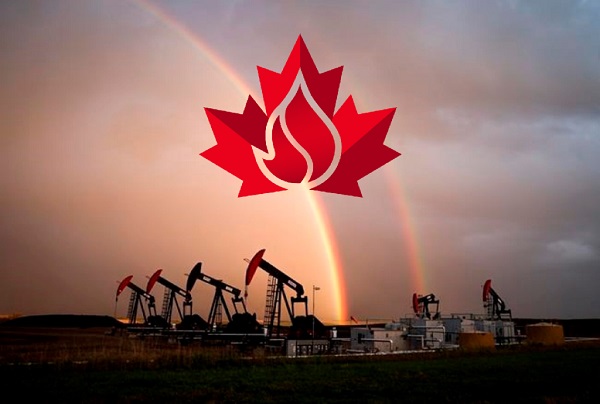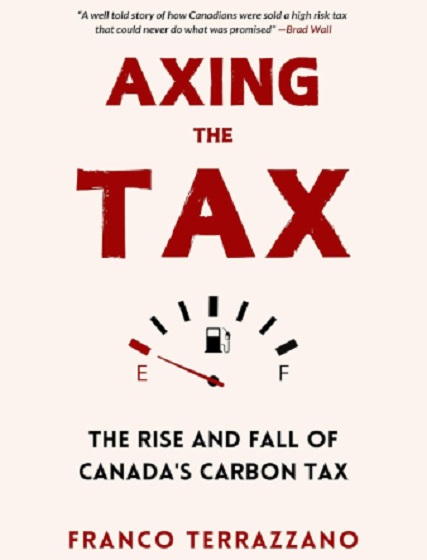Economy
Trump’s Wakeup Call to Canada – Oil & Gas is Critical to our Economy

From EnergyNow.Ca
By Jim Warren
On the bright side, at least President Donald Trump’s threat to impose 25% tariffs on Canadian oil and gas, might have alerted some Central Canadians to the critical importance of oil and gas to the national economy. Trump’s tariff pronouncements may also have forced the Laurentian Elite to rethink the wisdom of allowing anarchy to reign in our immigration system and border management.
Any nation hoping to be a serious player in the areas of international trade and diplomacy needs to meet several critical criteria. Without them a country can have difficulty marketing its goods and services to the world and in retaining meaningful economic and political sovereignty. One of the key criteria is for a country to have a good measure of control over its borders. But there are other elements critical to having effective sovereignty and independence. Having access to versatile, readily transportable energy commodities like oil and gas is one of those essentials. Accordingly, oil and gas are considered strategically important industries.
Lacking any of the major building blocks of strategic economic sovereignty, like the steel and aluminum industries and a thriving manufacturing sector, as well as highly developed transportation sector and the energy industries needed to support all the other sectors can leave a country vulnerable to domination by others. The vulnerabilities can lead to economic and political crises for a country during trade wars, international disputes leading to trade sanctions and embargoes, shooting wars and big natural disasters. A lack of strong trade and military alliances can make matters even worse.
It’s not like there wasn’t a mountain of evidence underlining the strategic importance of oil and gas in the last few years. How smart was it for Angela Merkel to allow Russia, a state run by a psychopath and his team of criminal oligarchs, to control a major portion of its energy supplies? The Ukraine gets it. After its war with Russia began, the Ukrainian government allowed Russian gas to be piped across its territory to Eastern Europe for nearly two years. This was because they realized messing with a commodity critical to bordering states such as Hungary, Slovakia and Romania was politically hazardous.
It is true that a country can still have a thriving economy even if it is missing one or two items from the basket of strategically important industries. Singapore, for example, needs to import fossil fuel but is still considered one of Southeast Asia’s economic tigers. But this is only possible because Singapore is so good at most everything else. It has several other economic engines that perform exceptionally well.
Looking back several decades reminds us that Japan risked entering a World War to obtain the petroleum they needed. To get it, the Japanese concluded they needed to conquer parts of Indonesia. (Similarly they wanted Southeast Asia for its rubber.) They knew these were actions the US wouldn’t tolerate, but they decided they had to do them anyway.
While we’re on the topic of World War II, it is instructive to recall Hitler fought it with one hand tied behind his back. Germany had no oil of its own and gasoline refined from coal and the oil available from their Romanian ally were never enough. That’s why the German’s placed such great hopes in capturing Russia’s Caspian oil fields in 1943. Similarly, Hitler invaded Norway to ensure access to Swedish iron ore—another strategic commodity Germany lacked.
Canada’s oil revenues along with the taxes and royalties collected from those revenues are derived almost entirely from the oil we export to the US. Our export revenues for 2022, following the worst of the covid years, were $123 billion. They accounted for 15.8% of all Canada’s exports and 6.6% of GDP. The following year saw exceptionally high oil prices globally. That year the value of oil Canada’s oil production hit $139 billion and accounted for 7.1% of GDP. Pull even half of those revenues out of the Canadian economy for very long and we’re in economic depression territory.
So, thanks for the wakeup call president Trump. The fact Trump has indicated he will postpone his final decision until February 1, is of some comfort. Danielle Smith has met with him at Mar-a-Lago to make the case against tariffs on Canadian crude. Smith is among the most knowledgeable and capable people there are when it comes to oil and gas production and trade. We couldn’t hope for a better advocate for the producing provinces. She’s certainly a cut above Justin Trudeau and anyone else in his cabinet. Let’s hope Smith she managed to convince Trump how imposing tariffs would harm the economies of both countries.
There is an obvious way to prevent being in this sort of situation in the future – diversify our export opportunities by building more pipelines to tidewater. In my last column I focused on the difficulties involved in getting a pipeline built to the Atlantic coast. The challenges identified focused on the barriers thrown up by Quebec’s politicians and environmentalists. Trump’s ongoing tariff pronouncements suggest it would be in Canada’s national strategic interest to use whatever legal measures are required to sweep those barriers aside in both Quebec and British Columbia to get new tidewater pipelines built.
There is plenty the federal government can do to override the demands of municipalities, special interest groups and provincial governments in support of high national purposes and in emergencies. Section 91 of the constitution gives parliament broad, albeit somewhat vague, powers to do what needs to be done “to make laws for the peace, order and good government of Canada” in all matters not exclusively the jurisdiction of the provinces. And, you would think that if the heavy hand of the Emergencies Act can be used to prevent horn honking and traffic snarls in Ottawa, it could be employed to prevent the environmentally sanctimonious from blocking projects critical to our economic and political sovereignty. Of course doing any of this will require voting the Liberals out of office.
Sorry premier Ford, retaliatory tariffs and export taxes can’t be the only tools employed; especially when they cause self-inflicted wounds. Unfortunately, until we have more export opportunities for oil and gas we may need to limit our counter attacks on Americans to misleading travel directions and poor restaurant service.
Carbon Tax
The book the carbon taxers don’t want you to read

By Franco Terrazzano
Prime Minister Mark Carney wrote a 500-page book praising carbon taxes.
Well, I just wrote a book smashing through the government’s carbon tax propaganda.
It tells the inside story of the fight against the carbon tax. And it’s THE book the carbon taxers don’t want you to read.
My book is called Axing the Tax: The Rise and Fall of Canada’s Carbon Tax.
Axing the Tax: The Rise and Fall of Canada’s Carbon Tax
Every now and then, the underdog wins one.
And it looks like that’s happening in the fight against the carbon tax.
It’s not over yet, but support for the carbon tax is crumbling. Some politicians vow to scrap it. Others hide behind vague plans to repackage it. But virtually everyone recognizes support for the current carbon tax has collapsed.
It wasn’t always this way.
For about a decade now, powerful politicians, government bureaucrats, academics, media elites and even big business have been pushing carbon taxes on the people.
But most of the time, politicians never asked the people if they supported carbon taxes. In other words, carbon taxes, and the resulting higher gas prices and heating bills, were forced on us.
We were told it was good for us. We were told carbon taxes were inevitable. We were told politicians couldn’t win elections without carbon taxes, even though the politicians that imposed them didn’t openly run on them. We were told that we needed to pay carbon taxes if we wanted to leave a healthy environment for our kids and grandkids. We were told we needed to pay carbon taxes if we wanted to be respected in the international community.
In this decade-long fight, it would have been understandable if the people had given up and given in to these claims. It would have been easier to accept what the elites wanted and just pay the damn bill. But against all odds, ordinary Canadians didn’t give up.
Canadians knew you could care about the environment and oppose carbon taxes. Canadians saw what they were paying at the gas station and on their heating bills, and they knew they were worse off, regardless of how many politicians, bureaucrats, journalists and academics tried to convince them otherwise. Canadians didn’t need advanced degrees in economics, climate science or politics to understand they were being sold a false bill of goods.
Making it more expensive for a mom in Port Hope to get to work, or grandparents in Toronto to pay their heating bill, or a student in Coquitlam to afford food won’t reduce emissions in China, Russia, India or the United States. It just leaves these Canadians, and many like them, with less money to afford everything else.
Ordinary Canadians understood carbon taxes amount to little more than a way for governments to take more money from us and dictate how we should live our lives. Ordinary Canadians also saw through the unfairness of the carbon tax.
Many of the elites pushing the carbon tax—the media, politicians, taxpayer-funded professors, laptop activists and corporate lobbyists—were well off and wouldn’t feel the brunt of carbon taxes. After all, living in a downtown condo and clamouring for higher carbon taxes doesn’t require much gas, diesel or propane.
But running a business, working in a shop, getting kids to soccer and growing food on the farm does. These are the Canadians the political class forgot about when pushing carbon taxes. These are the Canadians who never gave up. These are the Canadians who took time out of their busy lives to sign petitions, organize and attend rallies, share posts on social media, email politicians and hand out bumper stickers.
Because of these Canadians, the carbon tax could soon be swept onto the ash heap of history. I wrote this book for two reasons.
The first is because these ordinary Canadians deserve it. They worked really hard for a really long time against the odds. When all the power brokers in government told them, “Do what we say—or pay,” they didn’t give up. They deserve to know the time and effort they spent fighting the carbon tax mattered. They deserve all the credit.
Thank you for everything you did.
The second reason I wrote this book is so people know the real story of the carbon tax. The carbon tax was bad from the start and we fought it from the start. By reading this book, you will get the real story about the carbon tax, a story you won’t find anywhere else.
This book is important because if the federal Liberals’ carbon tax is killed, the carbon taxers will try to lay blame for their defeat on Prime Minister Justin Trudeau. They will try to say that carbon taxes are a good idea, but Trudeau bungled the policy or wasn’t a good enough salesman. They will try to revive the carbon tax and once again make you pay more for gas, groceries, and home heating.
Just like with any failed five-year plan, there is a lingering whiff among the laptop class and the taxpayer-funded desk rulers that this was all a communication problem, that the ideal carbon tax hasn’t been tried yet. I can smell it outside my office building in Ottawa, where I write these words. We can’t let those embers smoulder and start a fire again.
This book shows why the carbon tax is and always will be bad policy for ordinary Canadians.
Franco’s note: You can pre-order a copy of my new book, Axing the Tax: The Rise and Fall of Canada’s Carbon Tax, here: https://www.amazon.ca/Axing-
2025 Federal Election
Fixing Canada’s immigration system should be next government’s top priority

From the Fraser Institute
Whichever party forms government after the April 28 election must put Canada’s broken immigration system at the top of the to-do list.
This country has one of the world’s lowest fertility rates. Were it not for immigration, our population would soon start to decline, just as it’s declining in dozens of other low-fertility countries around the world.
To avoid the social and economic tensions of an aging and declining population, the federal government should re-establish an immigration system that combines a high intake with strictly enforced regulations. Once Canadians see that program in place and working, public support for immigration should return.
Canada’s total fertility rate (the number of children, on average, a woman will have in her lifetime) has been declining, with the odd blip here and there, since the 1960s. In 1972, it fell below the replacement rate of 2.1.
According to Statistics Canada, the country’s fertility rate fell to a record low of 1.26 in 2023. That puts us in the company of other lowest-low fertility countries such as Italy (1.21), Japan (1.26) and South Korea (0.82).
Those three countries are all losing population. But Canada’s population continues to grow, with immigrants replacing the babies who aren’t born. The problem is that, in the years that followed the COVID-19 lockdowns, the population grew too much.
The Liberal government was unhappy that the pandemic had forced Canada to restrict immigration and concerned about post-pandemic labour shortages. To compensate, Ottawa set a target of 500,000 new permanent residents for 2025, double the already-high intake of about 250,000 a year that had served as a benchmark for the Conservative government of Stephen Harper and the Liberal governments of Paul Martin and Jean Chrétien.
Ottawa also loosened restrictions on temporary foreign worker permits and the admission of foreign students to colleges and universities. Both populations quickly exploded.
Employers preferred hiring workers from overseas rather than paying higher wages for native-born workers. Community colleges swelled their ranks with international students who were also issued work permits. Private colleges—Immigration Minister Marc Miller called them “puppy mills”—sprang up that offered no real education at all.
At the same time, the number of asylum claimants in Canada skyrocketed due to troubles overseas and relaxed entry procedures, reaching a total of 457,285 in 2024.
On January 1 of this year, Statistics Canada estimated that there were more than three million temporary residents in the country, pushing Canada’s population up above 41.5 million.
Their presence worsened housing shortages, suppressed wages and increased unemployment among younger workers. The public became alarmed at the huge influx of foreign residents.
For the first time in a quarter century, according to an Environics poll, a majority of Canadians believed there were too many immigrants coming into Canada.
Some may argue that the solution to Canada’s demographic challenges lie in adopting family-friendly policies that encourage couples to have children. But while governments improve parental supports and filter policies through a family-friendly lens—for example, houses with backyards are more family-friendly than high-rise towers—no government has been able to reverse declining fertility back up to the replacement rate of 2.1.
The steps to repairing Canada’s immigration mess lie in returning to first principles.
According to Statistics Canada, there were about 300,000 international students at postsecondary institutions when the Liberals came to power in 2015. Let’s return to those levels.
The temporary foreign worker program should be toughened up. The government recently implemented stricter Labour Market Impact Assessments, but even stricter rules may be needed to ensure that foreign workers are only brought in when local labour markets cannot meet employer needs, while paying workers a living wage.
New legislation should ensure that only asylum claimants who can demonstrate they are at risk of persecution or other harm in their home country are given refuge in Canada, and that the process for assessing claims is fair, swift and final. If necessary, the government should consider employing the Constitution’s notwithstanding clause to protect such legislation from court challenges.
Finally, the government should admit fewer permanent residents under the family reunification stream and more from the economic stream. And the total admitted should be kept to around 1 per cent of the total population. That would still permit an extremely robust intake of about 450,000 new Canadians each year.
Restoring public confidence in Canada’s immigration system will take much longer than it took to undermine that confidence. But there can be no higher priority for the federal government. The country’s demographic future is at stake.
-

 2025 Federal Election6 hours ago
2025 Federal Election6 hours agoMark Carney refuses to clarify 2022 remarks accusing the Freedom Convoy of ‘sedition’
-

 2025 Federal Election10 hours ago
2025 Federal Election10 hours agoPoilievre To Create ‘Canada First’ National Energy Corridor
-

 Bruce Dowbiggin8 hours ago
Bruce Dowbiggin8 hours agoAre the Jays Signing Or Declining? Only Vladdy & Bo Know For Sure
-

 2025 Federal Election9 hours ago
2025 Federal Election9 hours agoFixing Canada’s immigration system should be next government’s top priority
-

 Daily Caller7 hours ago
Daily Caller7 hours agoBiden Administration Was Secretly More Involved In Ukraine Than It Let On, Investigation Reveals
-

 Freedom Convoy2 days ago
Freedom Convoy2 days agoFreedom Convoy leaders Tamara Lich, Chris Barber found guilty of mischief
-

 COVID-192 days ago
COVID-192 days agoTrump’s new NIH head fires top Fauci allies and COVID shot promoters, including Fauci’s wife
-

 2025 Federal Election2 days ago
2025 Federal Election2 days agoPoilievre promises to drop ‘radical political ideologies’ in universities

